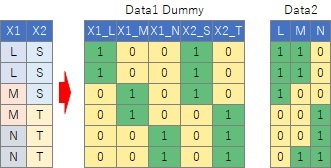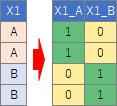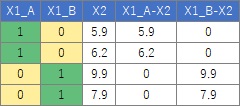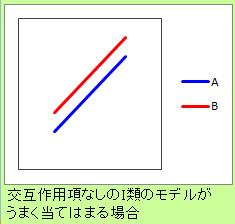
Quantification theory 1Quantification type I is a kind of quantification theory . The original quantification type 1 is a method of analyzing data of type Data1 by multiple regression analysis using the explanatory variable X.
The broader quantification type 1 on this page assumes that you want to analyze data of type 2 in the same way.

Let's start with the simplest example.
As a simple example, suppose you have qualitative data with only one explanatory variable and two names, "A" and "B". In such a case, if you perform dummy conversion and set X = 1 for A and X = 0 for B, for example, the formula
Y = X + 1.3
can be obtained by quantification type I. increase. This formula has the same meaning as when
Y = 2.3 ・ ・ ・ when A,
Y = 1.3 ・ ・ ・ when B.
In other words, the model that treats qualitative variables as dummy variables is the model when the Y-intercept is deviated. In other words, for each category stratification looking for a Y-intercept with.

When the explanatory variables are a mixture of quantitative and qualitative variables, multiple regression analysis can be performed by performing a dummy transformation on the qualitative variables, but the qualitative variables affect the Y-intercept. It is the part of.
For example, if Mr. A and Mr. B have a better model fit considering the deviation of the Y-intercept, this analysis is effective. However, if the slope of the formula changes due to the difference between Mr. A and Mr. B, this model is not good.

Models with multiple slopes can be created by processing the data.
As an example, suppose you have one explanatory variable and one qualitative variable. Create the product of this quantitative variable and the dummy variable of the qualitative variable, and make it the third variable. By the way, this variable is called " interaction term " and " coefficient dummy ". The dummy variable used to shift the Y-intercept as described above is called the " constant term dummy ".

Then, multiple regression analysis is performed with the quantitative variable, the dummy variable of the qualitative variable, and the third variable. This is a model with multiple slopes.
If the third variable has a significant effect on the model, we have tested that Mr. A and Mr. B have different slopes . Also, if the dummy variable significantly affects the model, it means that Mr. A and Mr. B have tested different Y-intercepts .


A model that changes the intercept and slope for each category using dummy variables is called a linear mixed model .
There are not many software that includes the item "Quantification type 1", but since quantification type 1 can be realized by devising explanatory variables, it can be done if there is software that includes regression analysis.
R-EDA1 has a linear mixed model item, so you can use this function to perform quantification type 1.
NEXT 

 Broadly defined Quantification theory 2
Broadly defined Quantification theory 2
